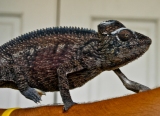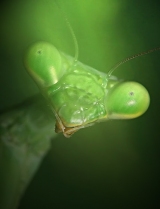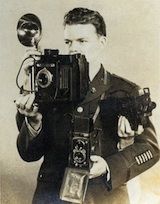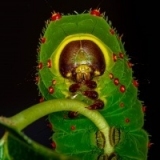- Forum
- Photography and Camera Forum
- Photo Galleries - For General Display or Critique
- Macro Photography
- Wanting to know some basic do's and don'ts for someone who wants to starte Macro
Wanting to know some basic do's and don'ts for someone who wants to starte Macro
-
 Topic Author
Topic Author
- Arkangel7x3
- The Lounger
-
- Nikon D300
- Followers: 45
- Posts: 1374
-
Points:
390
Post #122162
"If it's to good to be true best to shoot it again"
-

- dang
- Snapobsessed
-
- Primarily Canon, but I've owned and shot with everything from 110 to 8x10.
- Followers: 65
- Posts: 434
-
Points:
32
Post #122176
"True Macro" means reproduction should be life-size, or above. Anything less would be considered "Close Up". So when looking at lenses be sure they have one to one (1:1) magnification, since many lenses labeled "macro" only reproduce as little as 1/5th (1:5) life size on the film/sensor.
Other things to consider are "angle of view"... Please check this post for explanation.
Nikon has a couple of "true" macro lenses available, and several "after-market" companies such as Tamron, and Sigma do also. Either you choose should do fine, since all true macro lenses are generally sharp corner, to corner.
Once you purchase a lens, depending on what you intend on doing with your shots (web posting, or will you be doing large prints) will decide the amount of cropping you'll be able to do. So additional accessories such extension tubes, converters, and bellows will increase magnification even further.
You'll also find a tripod, or flash (most preferred) will be needed when shooting insects. But above all, patience is the key.
I'm sure others have additional advice, or post any questions and everyone here will be glad to help.
Welcome to the "tiny world".
Insanity: doing the same thing over, and over again expecting different results. (Albert Einstein)
www.dangphoto.weebly.com
-

- Shadowfixer1
- Photo Elder
-
- Olympus OMD E-M1 MKII
- Followers: 1350
- Posts: 5559
-
Points:
73585
Post #122287
-

- MLKstudios
- Banned
-
- D800 ;-)
- Followers: 72
- Posts: 4480
-
Points:
2
Post #122294
I just wanted to add that Nikon labels their "macro" lenses as micro-Nikkor. In reality "micro" is 10:1 and greater (10x and above) and usually requires the use of a microscope.
Just an FYI.
PS Shadow is right that true macro lenses can be costly. A good alternative is to get the filters and/or tubes he mentions that can be added to a true macro lens when acquired.
Matthew L Kees
MLK Studios Photography School
www.MLKstudios.com
[email protected]
"Every artist, was once an amateur"
-

- Baydream
- Moderator
-
- Canoni/60D/70D/5DmkIII
- Followers: 388
- Posts: 11185
-
Points:
7280
Post #122298
The Macro Master has spoken. Thanks, dang.dang wrote: Hi Michael,
"True Macro" means reproduction should be life-size, or above. Anything less would be considered "Close Up". So when looking at lenses be sure they have one to one (1:1) magnification, since many lenses labeled "macro" only reproduce as little as 1/5th (1:5) life size on the film/sensor.
Other things to consider are "angle of view"... Please check this post for explanation.
Nikon has a couple of "true" macro lenses available, and several "after-market" companies such as Tamron, and Sigma do also. Either you choose should do fine, since all true macro lenses are generally sharp corner, to corner.
Once you purchase a lens, depending on what you intend on doing with your shots (web posting, or will you be doing large prints) will decide the amount of cropping you'll be able to do. So additional accessories such extension tubes, converters, and bellows will increase magnification even further.
You'll also find a tripod, or flash (most preferred) will be needed when shooting insects. But above all, patience is the key.
I'm sure others have additional advice, or post any questions and everyone here will be glad to help.
Welcome to the "tiny world".
Shoot, learn and share. It will make you a better photographer.
fineartamerica.com/profiles/john-g-schickler.html?tab=artwork
-
 Topic Author
Topic Author
- Arkangel7x3
- The Lounger
-
- Nikon D300
- Followers: 45
- Posts: 1374
-
Points:
390
Post #122300
"If it's to good to be true best to shoot it again"
-

- Screamin Scott
- Moderator
-
- Nikon D610, Nikon D7100, Nikon D300, Olympus OMD E-M5 MarkII, Olympus OM-D E-M10, Olympus Pen E-P3 + film SLR's
- Followers: 1384
- Posts: 6858
-
Points:
40052
Post #122304
Randy & Tom have given you some good advice above. I shoot with a Nikon D70s & shoot a lot of macro/close up shots. As Tom said, a flash (ring light preferably) is a good investment when shooting macro as it allows you to stop motion easier than a fast shutter speed would. Randy has solid advice about using dual dioters such as the Canon 500D, Nikon 5T & 6T (out of production though). Since you have the 18-55 kit lens & no other lens listed on your profile, the 3T & 4T dual diopter lenses would be better suited as they are the same filter size as your lens (52mm) The 5T/6T are 62mm & the Canon can be found in assorted filter sizes. I shoot my macro/close up shots with older manual focus macro lenses, but the camera won't meter with them. Once you get used to using the LCD/histogram/"Sunny 16 rule" to determine exposure, that lack of metering really isn't a big problem. With most macro shooting, the exposure doesn't vary greatly so only minor adjustments are needed (& can be done in post if you shoot raw). The flash is the biggest help though as it allows for stopping motion & the use of smaller aperture settings for increased DOF...A big plus of your camera is the 1/500th sync speed...If you look at my galleries, all of my macro & close up shots in there are with a 1980's manual focus macro lens, the "Lester Dine 105mm F2.8"
-

- Screamin Scott
- Moderator
-
- Nikon D610, Nikon D7100, Nikon D300, Olympus OMD E-M5 MarkII, Olympus OM-D E-M10, Olympus Pen E-P3 + film SLR's
- Followers: 1384
- Posts: 6858
-
Points:
40052
Post #122322
- Forum
- Photography and Camera Forum
- Photo Galleries - For General Display or Critique
- Macro Photography
- Wanting to know some basic do's and don'ts for someone who wants to starte Macro
Latest Reviews
The Fujifilm XT5 is a 40MP mirrorless camera capable of 6.2K video at 30p. With those specs, it’s an ideal choice for photographers needing a camera to pull double duty for imaging and video.
The Canon EOS R100 is an entry-level mirrorless camera introduced in 2023. But just because it’s an entry-level camera doesn’t mean it’s a bare-bones camera. Find out why in this review!
Nikon’s retro-looking Nikon Zfc is anything but retro. Under its classic body is a host of features and amenities that make it a worthwhile compact mirrorless camera for 2024.
The Canon EOS R50 is one of the newest R-system cameras from Canon. Is it worth your money? Find out all the details you need to know in this comprehensive review.
Forum Top Posters
-
1Screamin Scott 3 posts
-
2Adam Wilson 2 posts
-
3Kelly Emery 1 post
-
4db3348 1 post
-
5lesno1 1 post
Latest Articles
Urban photography is a genre showcasing features in urban settings. You can photograph people, architecture, mass transit, and many other subjects. Learn how to do so in this guide!
The Nikon D850 might be an older DSLR, but it was ahead of its time when it debuted in 2017. That means it still has plenty of firepower to compete with today’s powerful mirrorless cameras.
The best beginner camera isn’t the same for everyone. That means having choice is of the utmost importance. In this guide, explore five excellent beginner camera options for 2024 and beyond.
Child portrait photography is a unique undertaking requiring special skills and talents to get the best results. Start mastering this photography niche with these essential tips!
The Fujifilm XT5 is a 40MP mirrorless camera capable of 6.2K video at 30p. With those specs, it’s an ideal choice for photographers needing a camera to pull double duty for imaging and video.
Using leading lines in photography helps improve the composition by drawing viewers in and leading their eye from the foreground to the background. Explore some fine examples of this in this guide!
The Insta360 has one of the best lineups of action cams and 360-degree cameras. With these Insta360 accessories, you can elevate your photography and videography game!
Creating impactful photos of landscapes depends on many factors, not the least of which is your talent behind the lens. This guide explores other elements required for the best product.
















